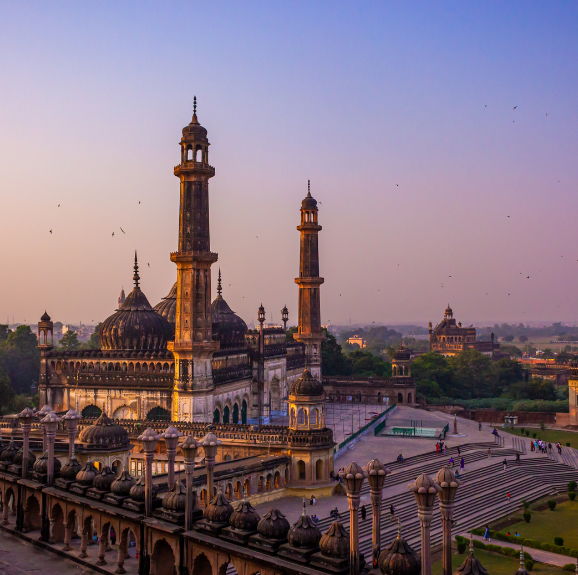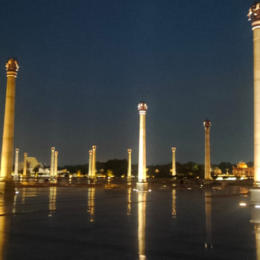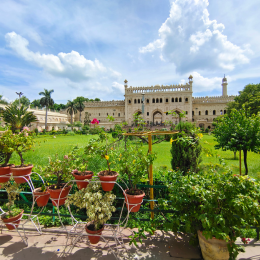Lucknow, the capital of Uttar Pradesh, is a city that gracefully combines rich history, refined culture, and architectural brilliance. Known for its legendary hospitality and "tehzeeb" (refined etiquette), Lucknow offers visitors a unique blend of Nawabi
heritage, Awadhi cuisine, and magnificent monuments. This cultural gem was once the heart of the Nawabs of Awadh, and its legacy still lingers in the city’s splendid architecture, royal traditions, and vibrant
arts.
Lucknow: A City of Nawabi Grandeur and Cultural Elegance
Uttar Pradesh, India



Overview
Historical Significance
Lucknow has a history that stretches back to ancient times but truly flourished during the rule of the Nawabs of Awadh in the 18th and 19th centuries. The Nawabs, who ruled the region under the Mughal Empire, were patrons of art, culture, and architecture,
transforming the city into a major center of culture, politics, and trade. During this period, Lucknow became known for its refined manners, its culinary delights, and the beautiful monuments that still
stand today.
Lucknow also played a pivotal role in the 1857 Indian Rebellion (also known as the Indian Mutiny or First War of Independence), with fierce battles fought between British forces and the rebels. The ruins of the Residency, the British stronghold during the uprising, stand as a stark reminder of this tumultuous chapter in Indian history.
Lucknow also played a pivotal role in the 1857 Indian Rebellion (also known as the Indian Mutiny or First War of Independence), with fierce battles fought between British forces and the rebels. The ruins of the Residency, the British stronghold during the uprising, stand as a stark reminder of this tumultuous chapter in Indian history.
Key Attractions
Bara Imambara
Chota Imambara
Rumi Darwaza
The Residency
Imam Bara Complex
Agra is not just a city of monuments; it is also a vibrant cultural hub. The city's culture is deeply influenced by its Mughal heritage, and visitors can experience traditional Mughal crafts such as marble inlay work, leather goods, carpets, and brassware.
These handcrafted products can be found in Agra's bustling bazaars and markets, where artisans showcase their skills.
1.Kebabs
- Lucknow is synonymous with kebabs, especially the world-famous Tunday Kebab. These tender, flavorful kebabs are made from minced meat, spiced with a variety of aromatic herbs and cooked to perfection. Galouti Kebabs, with their melt-in-the-mouth texture, are also a delicacy unique to Lucknow.
2.Biryani
- The Lucknowi Biryani is a fragrant, mildly spiced rice dish made with basmati rice, succulent pieces of meat, and slow-cooked to perfection. It is distinct from other regional biryanis, using kacchi (raw) meat cooked with the rice, which enhances its flavor and tenderness.
3.Chikanari (Chikan Embroidery)
- Chikanari is an ancient form of embroidery that originated in Lucknow. The delicate, intricate patterns created using needle and thread are found on a wide range of fabrics, from kurtas to sarees. This craftsmanship has become one of the city’s most prized cultural exports.
4.Petha
- Petha, a translucent, sweet candy made from ash gourd, is a traditional dessert that has been popular in Lucknow for centuries. It is often flavored with rose or saffron, giving it a unique and refreshing taste.
Lucknow is also known for its vibrant dance and music traditions, with the classical dance form of Kathak having a strong historical association with the city. The city has
produced some of India’s finest Kathak dancers, and performances can often be seen at cultural events, temples, and private gatherings.
Lucknow Gharana is a famous school of classical music, particularly known for thumri , a light classical vocal form that originated in this region. Ghazals, qawwalis, and Nawabi poetry (especially Urdu poetry ) are other artistic traditions that continue to thrive in the city.
Lucknow Gharana is a famous school of classical music, particularly known for thumri , a light classical vocal form that originated in this region. Ghazals, qawwalis, and Nawabi poetry (especially Urdu poetry ) are other artistic traditions that continue to thrive in the city.
Lucknow is a paradise for shoppers, especially those interested in traditional handicrafts. The Chikanari embroidery, as well as zari (golden thread work), kashidakari, and phulkari are popular items found in Lucknow’s bazaars. Markets like Hazratganj
and Aminabad offer everything from vibrant fabrics, elegant clothing, and intricate jewelry to local artifacts. The city’s Attar (traditional perfume) makers also have a significant presence,
with their aromatic creations sold in local markets.
Lucknow celebrates a variety of festivals with grandeur, and Eid, Diwali, and Holi are particularly special. During Ramzan, the city sees a festive atmosphere with special evening prayers, delicious food, and vibrant street life. Muharram is also a time
for solemn observances, with processions and gatherings taking place throughout the city, especially near the Imam Baras.
Conclusion
Lucknow is a city where history, culture, and tradition converge in the most elegant way. From the majestic Bara Imambara to the delicate craftsmanship of Chikanari embroidery, and from the aroma of kebabs to the sound of Kathak performances, Lucknow
offers a rich and diverse cultural experience that reflects the city's Nawabi grandeur. It’s a place where the old-world charm of the Nawabi era coexists with the hustle and vibrancy of modern life, making
it one of the most enchanting destinations in India.

